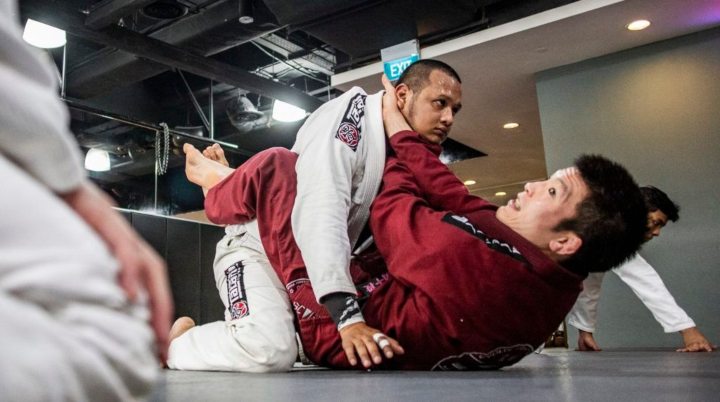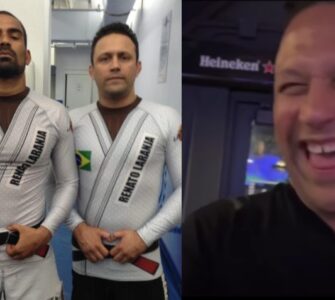Guest post by Evolve MMA, Asia’s premier championship brand for martial arts. It has the most number of World Champions on the planet. Named as the #1 ranked martial arts organization in Asia by CNN, Yahoo! Sports, FOX Sports, Evolve MMA is the top rated BJJ gyms.
The guard is the most unique position found in Brazilian Jiu-Jitsu (BJJ). It is a position that separates BJJ from other grappling arts, and it has been historically viewed as an inferior position to be in a fight. Show your average person a video of two people fighting in the guard and most automatically assume the guy on the bottom is losing.
That’s what makes BJJ so special. It turns what has been traditionally seen as a poor position for the fighter on the bottom, into an offensive position with many ways to end the fight or sweep to a more dominant position.
Learning the fundamentals of this position should be a priority for every BJJ student. You should always feel comfortable here whether you are on top or the bottom, if you call yourself a BJJ practitioner.
Here are 5 common mistakes beginners often make when playing guard.
1) Keeping the guard closed
It is almost natural to close your guard and keep your legs closed when you first start BJJ. While a closed guard has many uses, it does limit your options offensively. Many sweeps and submissions require the use of your legs, so you will need to be comfortable with your open guard as well.
You also learn how to use other guard variations like the butterfly guard or X-guard. Being familiar with different types of guard variations will give you more confidence when you are on your back.
You won’t always be able to regain your full guard when you roll, so it is good to have other options.
Do not be content with simply holding people down with a closed guard. That only works on other beginners and you do not learn anything. Open up your guard and only use a closed guard when necessary. You will learn a lot more that way.
2) Staying flat
Many BJJ newbies instinctively lay flat on their back in bottom positions. In BJJ, that only makes things easier for your opponent. The friction created by your back and the mat slows you down, while your opponent is free to move as he/she likes once your guard is broken.
Turning to a side makes it easier for you to move your hips, making it easier to regain your guard or prevent your opponent from progressing further.
One of the effective ways to drill this to your muscle memory is by performing shrimping drills. These drills require you to lay on a side while moving your hips and legs. The motion is the basis for many escapes and techniques in BJJ.
3) Hanging on to things too long
BJJ is one of the most cerebral martial arts. It’s a lot like a game of chess. You are constantly countering your opponent’s movements, while they do the same to you. A big part of playing guard is learning when to let go of certain things.
For example, if you go for a triangle from your guard and your opponent postures up, the intelligent thing to do is to let go if you are unable to break the person’s posture. Holding on to a triangle when an opponent has postured up only makes it easier for him/her to stack you or go for a standing pass. A better tactic would have been to let go of the choke and use the opportunity to escape or work a sweep.
Stubbornly holding on to submissions or grips that are clearly not there will cost you good positions and even get you submitted from time to time. That holds true for all positions in BJJ.
4) Not using proper grips
It is very important that you learn to use all the different parts of your body when executing techniques. New BJJ students tend to play open guard with only their feet, and that only makes it easier for others to pass their guard.
Pay attention when techniques are being broken down during class and make sure you are using the proper grips for each technique you try to execute. Don’t just mindlessly grab on your opponent without thinking about what you are doing. For example, if you are grabbing on your opponent’s head from guard, you should be pulling him/her towards you so that he/she can’t posture up.
There is a huge difference between simply going through the motions when it comes to proper hand and foot positions and actually using your hooks and grips to make it harder for someone to pass your guard.
5) Not exploring all your options
Those who are new to BJJ sometimes have a hard time remembering that they have many options when playing guard. There are a countless number of submissions you can pull off from there, as well as sweeps and reversals. Try not to become one-track minded when in your guard.
For example, while the kimura from guard bottom is a simple and basic submission, it can be hard to pull off on opponents who recognize what you are trying to do and are stronger. You could keep going for the move, with your opponent escaping every time, or you could look for something else. You could go for a submission that gives you more leverage or you could sweep the person and end up in the top-mount position.
Everyone’s guard is unique and you should develop yours based on the things you are good at. If you have a knack for getting submissions from guard, there’s nothing wrong with staying there and looking for a sub. If you barely know any submissions from there, you should be focusing on getting to a position you feel more comfortable in.
Make you guard work for you. Develop it to suit your personality and style.
You’re not really a BJJ practitioner if you feel like a fish out of water in the guard. It is the essence of BJJ, and one of those positions you need to master if you plan to compete. It’s also a position that has been proven to be effective in self-defense scenarios.

















